If you’ve read our review of the base Traeger Woodridge, you know it’s a clear upgrade from the old Pro series. It has a better build, easier cleanup, and a more modern design that fits what people expect in 2025.
But if I’m honest, there wasn’t much to get excited about. It felt solid, but safe.
That’s why I was curious to try the Woodridge Pro. It’s the middle option between the base and Elite models, and Traeger is positioning it as their new mid-range pick.
I’ve owned and cooked on the Ironwood XL for years. That grill used to hit the sweet spot for value and features, so I was especially interested to see how the Woodridge Pro stacks up.
In this review, I’ll break down what I liked, what fell short, and whether this grill is worth your money.
Traeger sent me this grill for free in exchange for an honest review; all opinions are my own.
Our Verdict
The Woodridge Pro is an easy upgrade over the base model and a smart way to get Traeger’s best features without paying Ironwood prices. You get Super Smoke mode, a large 970 in² cooking area, folding side shelf and thoughtful extras like Keep Warm mode and built-in grate storage.
While the build quality isn’t on par with the Ironwood or Timberline, it’s still a big improvement over the older entry-level Traeger Pro. If you’re choosing between the base Woodridge and the Pro, this one’s a no-brainer. For just a bit more, you get a much better smoking experience.
Pros
- Super Smoke mode adds noticeable flavor
- Traeger app is more reliable and easier to use than any other grill app
- Keep Warm mode works well for resting meat without needing a cooler
- Staging hooks let you hang grates during cleaning or storage
- Pellet consumption is efficient and the 24 lb hopper lasts through long smokes
Cons
- No built-in lights in the grill chamber or hopper.
- Build feels lighter and less sturdy than Ironwood
- Smoke leaks slightly from the lid due to lack of a gasket
- Smoke flavor drops off noticeably above 325°F
- Max temperature is capped at 500°F, limiting searing ability
- The top rack doesn’t cook as evenly and takes up usable space
Traeger Woodridge Pro vs The “Other Guys”
The Woodridge Elite adds an infrared sear station and a better cart with an enclosed storage area. We are still waiting on our test model and will update our review once we have tested it out.
Who should buy
Get this middle-of-the-range Woodridge Pro if you:
- Want Traeger’s best tech without the Ironwood or Timberline price tag.
- Are looking for a solid, spacious pellet grill that’s easy to use and easy to clean.
- Mainly cook low and slow, and want Super Smoke mode to boost flavor.
Don’t buy if
You might want to skip this grill if you:
- Prefer a heavier-duty build with thicker steel and more insulation.
- Want to sear steaks at temps above 500°F.
- If you want more smoke flavor when cooking over 325°F, the Camp Chef Woodwind Pro might be a better option.
- And if you want to go American-made then look at the Yoder YS640S.
Assembly
The Woodridge Pro arrives unassembled on a pallet, like most pellet grills.
Traeger does a great job with their packaging and instructions. Everything you need is included, and the step-by-step directions are clear and easy to follow. You get a printed manual, plus digital instructions in the Traeger app. If you’re more of a visual learner, they also have helpful YouTube videos that walk you through the setup.
Assembly took me about an hour from start to finish. No surprises—it was about what you’d expect for a grill this size.
One fun bonus: Traeger designs their packaging so the boxes double as a playset for kids. It’s a clever way to make recycling more fun, and it’s something I’ve always appreciated as a parent.
Build Quality
The Woodridge Pro feels noticeably lighter and less rugged than higher-end Traeger models like the Ironwood. That’s not surprising, considering it costs about $850 less, but it’s something to be aware of if you’re used to Traeger’s premium builds.
Most of the cost savings show up in the materials. The lid and chamber are made from thinner steel than I expected, and the legs feel a bit more lightweight, too.
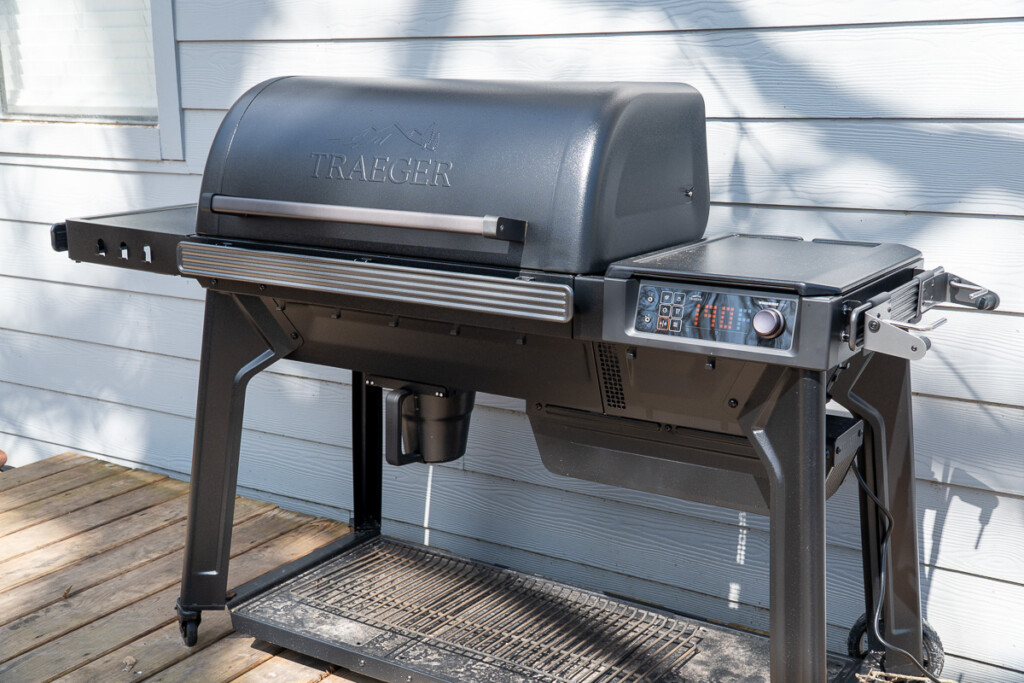
The Woodridge doesn’t have the same sturdy, tank-like feel you get with the Ironwood.
One feature I really missed was the integrated lighting. The Ironwood has lights in both the grill chamber and the hopper, which is a huge help when cooking at night. That small but useful touch didn’t make it into the Woodridge Pro, and I was honestly bummed to see it left out.
The lid also lacks the insulation gasket that helps seal in heat and smoke on the Ironwood. I noticed a bit of smoke leaking during longer cooks. Not a major issue, but worth noting.
That said, the Woodridge Pro is still a big improvement over the older entry-level Traeger Pro. It doesn’t match the Ironwood’s build, but for this price point, the quality is right where I’d expect it to be.
Pellet Ash and Dust
During the initial burn-off and seasoning of the Woodridge Pro, I noticed something unusual. It kicked out a lot more dust and ash than I expected. I’ve used plenty of pellet grills over the years, and I’ve never seen one blow this much ash into the cooking chamber right out of the gate.
This is consistent with our experience cooking on the base Woodridge model.
And yes, I was using Traeger-brand pellets, the same ones they recommend for best performance.
By the time the burn-off was done, the inside of the grill was fully coated in dust. There wasn’t any food on the grates yet, but it definitely gave me pause before starting my first real cook.
The EZ-Clean Grease & Ash Keg is designed to catch both grease and pellet ash as you cook. It does help, but in my experience, a noticeable amount of ash still escapes into the chamber. It’s not enough to ruin your food, but it does make the grill feel messier than it should.
I wouldn’t call it a deal-breaker, but I’d like to see better containment in future updates.
Cooking on the Woodridge Pro
I’ve been using the Woodridge Pro regularly for the past three months, and I’ve put it through a wide range of cooks. Like most pellet grills, it’s straightforward to use. Load the hopper, set your temp, and let it do its thing.
For low-and-slow cooks like pork butts and hams, it performed really well. The temperature stayed steady, and I got an even flavor throughout the meat. Smoke penetration was solid, especially when running the Super Smoke mode at 225°F or below. That feature definitely adds a little extra punch when you’re looking for more smoke flavor.
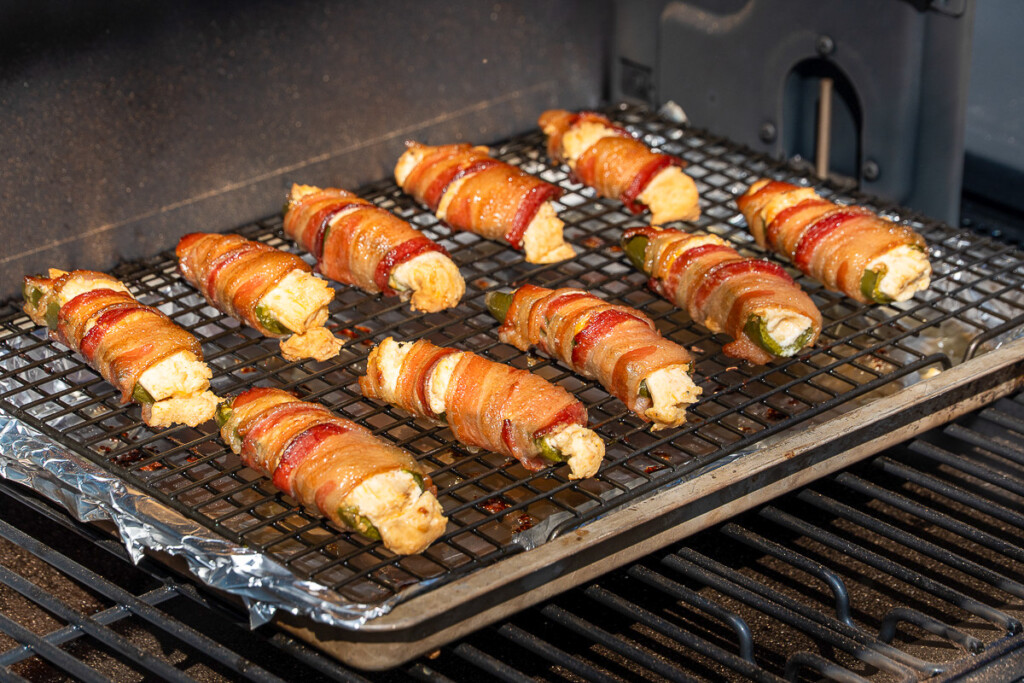
At higher temps, I tested it out with dips, jalapeño poppers, and armadillo eggs. The grill handled everything evenly and browned bacon nicely. But, as with most pellet grills, the smoke flavor dropped off once I got past 325°F. It’s a bit of a letdown if you’re chasing that deep smoky profile at higher temps, but it’s not unusual for this type of grill.
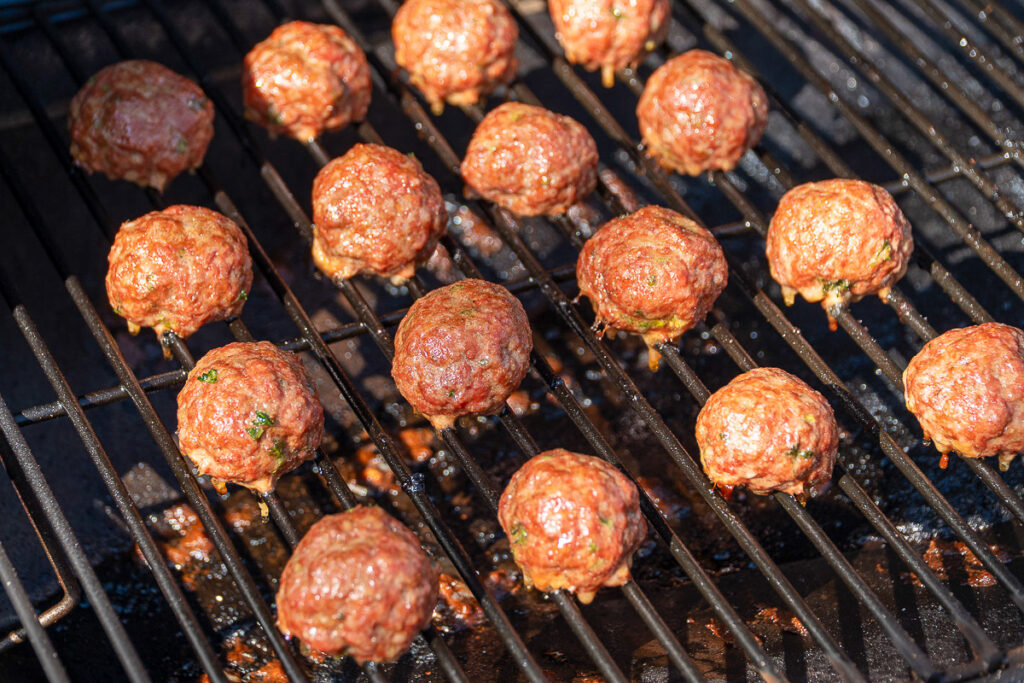
Overall, the Woodridge Pro cooks consistently and is easy to trust for both large and small cooks. Just don’t expect heavy smoke flavor on the hotter end of the range.
Temperature Performance
The Woodridge Pro holds steady temperatures and runs about as efficiently as you’d expect for a pellet grill in this range. At low-and-slow temps around 225°F, you’ll burn through roughly 1 pound of pellets per hour. Crank it up to 450°F, and that jumps to about 3 pounds per hour.
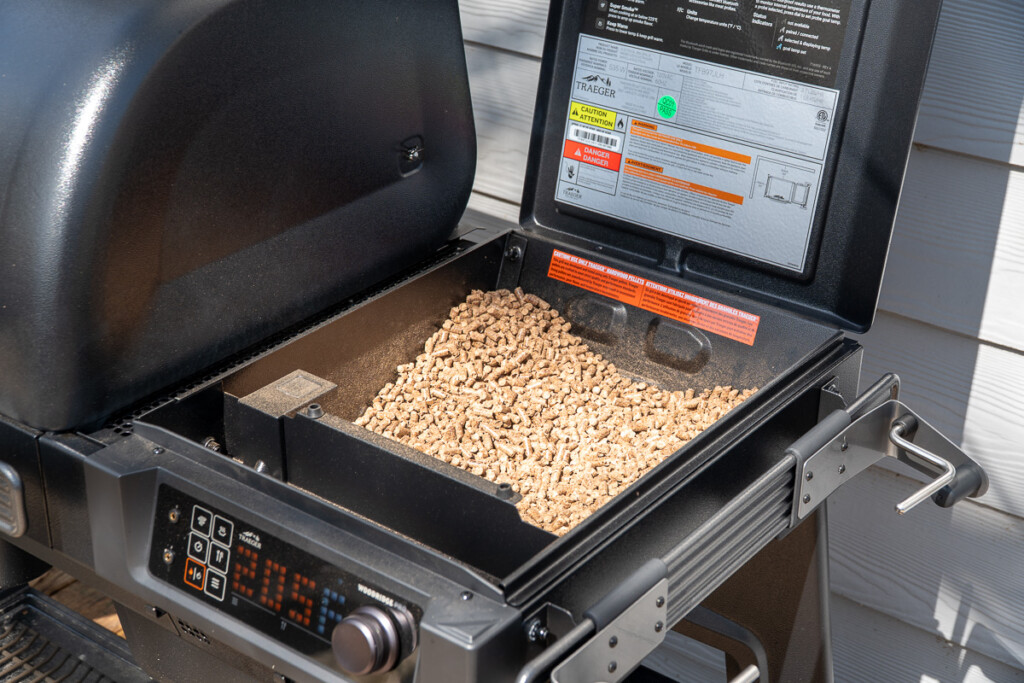
The 24 Lb hopper is more than large enough for long overnight cooks.
I’ve had no issues with temp swings, and the grill recovers quickly after opening the lid. It holds heat well for a single-walled body and doesn’t spike or dip erratically like some cheaper models.
The Super Smoke function adds a nice boost in flavor when cooking at lower temps. That said, you still get the typical drop in smoke output above 325°F, which is common across most pellet grills
Cooking Capacity
At 970 square inches total, the Woodridge Pro actually gives you slightly more room than my Ironwood XL, which is wild considering the price difference.
But there’s a catch.
That big number comes from a larger-than-usual upper rack, which accounts for 385 square inches.

The top rack sticks out to cover more of the bottom rack than I’m used to.
In practice, the top rack is fine for racks of ribs, veggies, or warming trays. But it’s not ideal for big cuts of meat like briskets or pork butts due to the vertical clearance.
I also found that the top rack doesn’t cook as evenly. Like most pellet grills, the heat is more concentrated on the main grate. I usually remove the top rack unless I really need the space, which cuts into the total usable area.
If you’re cooking for a family, the space is more than enough. But once you remove the top rack for airflow or size, you’re working with a lot less room than the full spec suggests.
Digital Display and Temperature Control
The Woodridge Pro uses a digital display that’s a little different from other Traeger models. It’s not as polished as the Ironwood or Timberline screens, but it’s easy to read and simple to use.
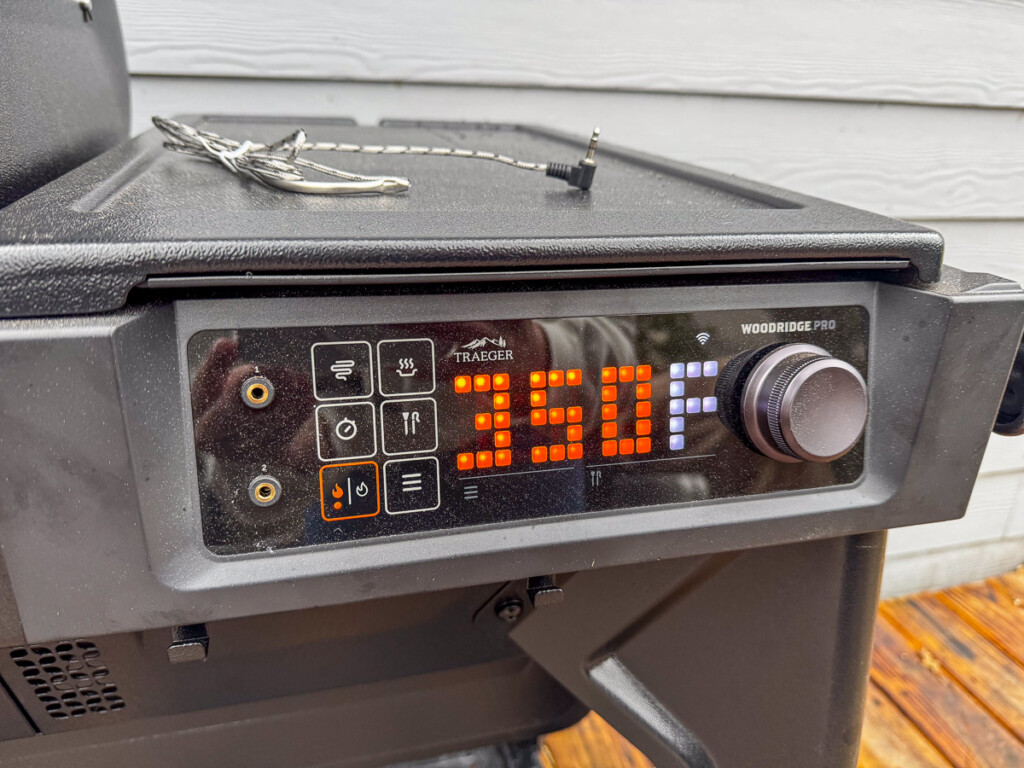
The readout has a futuristic feel. It works just fine, but it looks a bit like a throwback sci-fi gadget. Some folks might love it, others might find it a little odd.
To fire it up, turn the knob to your desired temp, then press the Ignite button. For shutdown, hold the same button for three seconds, and the display will count down. You can also shut it off straight from the Traeger app, which is handy if you’re already inside or wrapping up a cook.
The temperature range runs from 165°F to 500°F, covering everything from Keep Warm mode to basic searing. It doesn’t reach the 600°F range like some Weber or Recteq models, but for most backyard cooks, 500°F is plenty.
Final Thoughts on the Traeger Woodridge Pro
For a long time, Traeger had a problem.
Their entry-level Pro models topped out around $1,000, but you didn’t get any extra features with the larger size, just more space. If you wanted real upgrades like better construction, Super Smoke mode and interior lighting, your only option was to jump to the Ironwood, which meant spending close to double the money.
That left a pretty big gap in the lineup.
The new Woodridge series finally fixes that. Instead of a huge leap in price, you now have a more logical step-up path. Spend more, get more, both in terms of space and features.
And the Woodridge Pro hits a sweet spot. For just over $1,100, you’re getting Super Smoke, a better grease and ash system, and thoughtful design upgrades that make this feel like a true mid-tier grill, not just a bigger version of something basic.
If you still can’t decide which model to get, you can check out our video review of the base Woodridge.
If you’ve been eyeing a Traeger but couldn’t justify the cost of the Ironwood or Timberline, the Woodridge Pro gives you a much easier “yes.”
Did you miss our previous article...
https://manstuffnews.com/backyard-grilling/13-ways-to-make-better-chili
 Backyard GrillingWeekend WarriorsAdvice from DadBeard GroomingTV Shows for Guys4x4 Off-Road CarsMens FashionSports NewsAncient Archeology World NewsPrivacy PolicyTerms And Conditions
Backyard GrillingWeekend WarriorsAdvice from DadBeard GroomingTV Shows for Guys4x4 Off-Road CarsMens FashionSports NewsAncient Archeology World NewsPrivacy PolicyTerms And Conditions
